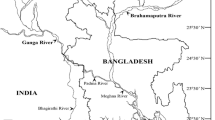Summary
Osmoregulation in the aquatic halophyte Ruppia was examined as part of a wider study of mechanisms of salt tolerance within the genus. The tissue fluids of the three species R. megacarpa Mason, R. polycarpa Mason and R. tuberosa Davis and Tomlinson, were always hypertonic to the surrounding water. The organic solute proline was accumulated, possibly as a mechanism to counteract the effects of high external salinities. Proline content increased with the salinity of the habitat in all three species. In general proline content increased while plant growth was active and declined later in the growing season. If the assumptions that proline is confined to the cytoplasm and that the cytoplasm comprises 10% of the cell volume are made for these submerged aquatic plants, proline is estimated to generate a solute concentration in this compartment equivalent to up to 50% of the total solute concentration of the external habitat.
Similar content being viewed by others
References
Bar-Nun N, Poljakoff-Mayber A (1977) Salinity stress and the content of proline in roots of Pisum sativum and Tamarix tetragyna. Ann Bot 41:173–179
Brock MA (1979) The ecology of salt lake hydrophytes: the synecology of saline ecosystems and the autecology of the genus Ruppia L. in the south-east of South Australia. PhD Thesis, The University of Adelaide
Cavalieri AJ, Huang AHC (1979) Evaluation of proline accumulation in the adaptation of diverse species of marsh halophytes to the saline environment. Am J Bot 66:307–312
Flowers TJ, Troke PF, Yeo AR (1977) The mechanism of salt tolerance in halophytes. A Rev Pl Physiol 28:89–121
Jefferies RL, Rudmik T, Dillon EM (1979) Responses of halophytes to high salinities and low water potentials. Pl Physiol 64:989–994
Singh TN, Aspinall D, Paleg LG (1972) Proline accumulation and varietal adaptability to drought in barley; a potential metabolic measure of drought resistance. Nature: New Biology 236:188–190
Singh TN, Paleg LG, Aspinall D (1973) Stress metabolism. I. Nitrogen metabolism and growth in the barley plant during water stress. A J biol Sci 26:451–456
Stewart GR, Lee JA (1974) The role of proline accumulation in halophytes. Planta 120:279–289
Storey R, Wyn Jones RG (1977) Quaternary ammonium compounds in relation to salt resistance. Phytochemistry 16:447–453
Troll W, Lindsley J (1955) A photometric method for the determination of proline. J Biol Chem 215:655–660
Williams WD (1966) Conductivity and the concentration of total dissolved solids in Australian lakes. Aust J mar Freshwat Res 17:169–176
Wrench P, Wright L, Brady CJ, Hinde RW (1977) The source of carbon for proline synthesis in osmotically stressed artichoke tuber slices. Aust J Pl Physiol 4:703–711
Author information
Authors and Affiliations
Rights and permissions
About this article
Cite this article
Brock, M.A. Accumulation of proline in a submerged aquatic halophyte, Ruppia L.. Oecologia 51, 217–219 (1981). https://doi.org/10.1007/BF00540604
Received:
Issue Date:
DOI: https://doi.org/10.1007/BF00540604




